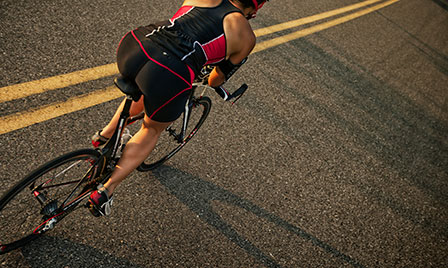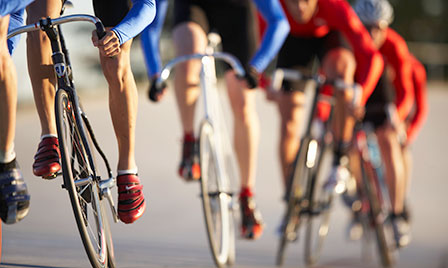
MOVE
Cycle smart to avoid injuries
Posted May 3, 2015
Minnesotans spend a lot of time on two wheels, whether for recreation, fitness or as a mode of transportation. No matter what your reason for biking, there are plenty of opportunities for cyclists to get injured. As you begin to spend more time on two wheels with the nicer weather, here are a few things to keep in mind to minimize your risk for injury.
Slowly increase time/distance. If your time on two wheels over the winter didn't include fat biking, spin classes or the stationary trainer, you will want to work slowly into increasing your distance. Increase your time or mileage by no more than 10% per week.
Limit intensity. As your muscles and tendons adapt to increased ride time, try to avoid interval workouts and excessive hill climbing by sticking to flatter trails, like the Midtown Greenway. This will help prevent tendonitis issues that could affect the rest of your season. Begin adding hill workouts after consistently riding four to five times per week for about 5 weeks.

Address flexibility. The flexibility needed for your bike positioning may be different than your off-season workouts and activities. Increasing your lower extremity and lower back flexibility can improve the range of motion needed for your riding position. Spend time stretching your hamstrings and glute muscles for the biggest impact.
Improve core strength. A strong core will help limit strain to the lumbar spine and pelvis region, as well as improve the efficiency of your leg muscles while pedaling. The plank and its many variations are good core strengtheners you can do almost anywhere.

Dress properly. When your joints stay warm they stay more lubricated and your muscles and tendons have less chance of irritation or inflammation. Dressing in layers will help you to stay warm but allow for removal of items if you start to get too warm.
Get a professional bike fitting. If you are having discomfort in your low back, neck or knees while on your bike, seek out a professional bike fitter. A professional bike fit can help solve issues, such as saddle height and reach adjustments, related to a poorly fitting bicycle. This can help minimize joint strain as well as muscle and tendon strain.
Use lower gearing/higher cadence. Using a lower gear than normal (bigger cog, smaller chain ring) will decrease the amount of force needed by the muscles and tendons and limit the chance of getting tendon inflammation.

Mind the road. It is important to stay mindful of who and what is on the road with you, whether that means other bikers, pedestrians, loose gravel or motor vehicles. Remember to obey traffic laws, be aware of your surroundings and ride predictably.
And while I'm sure it goes without saying, I'll say it anyways, wear your helmet. These suggestions along with listening to your body can help minimize injuries and lengthen your riding season. As with all injuries, if you are unsure of what pains you, it is best to consult with a health care professional.
This is National Bike Month and in its honor I encourage you to share your passion for two wheels and invite someone to ride along with you. Show them why we live in a bike-friendly state!
-
CycleSMART therapy
Learn more
MORE ARTICLES LIKE THIS
Get fun, inspiring, provider-reviewed articles sent to your inbox.
Sign up for our email newsletter




